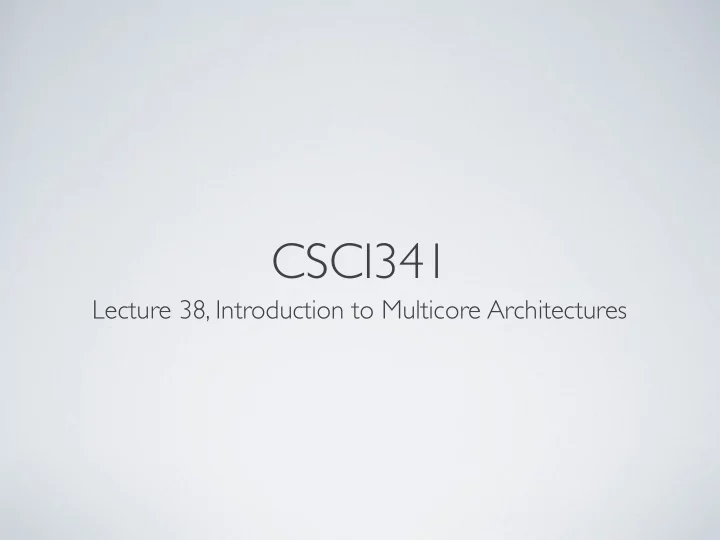

CSCI341 Lecture 38, Introduction to Multicore Architectures
GOAL: PERFORMANCE Recall: Power as the overriding issue. Performance, heat, power efficiency.
PIPELINING “Exploits potential parallelism among instructions.” “Instruction-level parallelism”
PROCESS-LEVEL PARALLELISM Utilizing multiple processors by running independent programs simultaneously.
PARALLEL PROCESSING PROGRAM Executing one program upon multiple processors simultaneously.
MULTI-PROCESSOR ARCHITECTURES A system with at least two processors.
MULTI-CORE ARCHITECTURES A system with multiple processors (“cores”) within a single integrated circuit.
SEQUENTIAL VS. CONCURRENT
THE PROBLEM (not about the hardware) It is difficult to write software that uses multiple processors that complete tasks faster. Why?
MUST YIELD THE BENEFIT The parallel implementation must be faster, especially as the number of processors increase. Otherwise, what’s the point? Single-processor instruction-level parallelism has evolved. (see superscalar & out-of-order execution)
COMPLICATIONS • scheduling • load balancing • time for synchronization • communication overhead • Amdahl’s law Example: multiple journalists writing a story.
SMP Shared Memory Multiprocessor Multiple processors, single memory address space. All cores have access to all data. (Multi-core architectures generally use this approach)
SMP
SYNCHRONIZATION Coordinating operations on shared data between multiple processors. Common solution: locks.
MESSAGE PASSING What if each processor has its own address space?
MESSAGE PASSING Pragmatically, manifests as clusters of individual machines. But, there’s a cost to administering these individual physical machines.
VIRTUAL MACHINES An additional layer of abstraction on top of hardware. Multiple cluster nodes on top of hardware, each capable of sending/receiving messages.
SO MUCH MORE... • Multithreading • MIMD (Multiple Instruction / Multiple Data Streams) • Vector architectures (see Cray) • GPUs
AND MORE... Storage & I/O (Chapter 6) One simple approach: memory-mapped I/O
AND MORE... Many instructions are loads/stores... how can we exploit the memory hierarchy?
PRINCIPAL OF LOCALITY • Temporal • Spatial
PRINCIPAL OF LOCALITY Memory closest to the processor fastest (most expensive).
HIERARCHY < 3 ns $2000/GB < 70 ns $20/GB < 20m ns $0.25/GB
HIERARCHY
HOMEWORK • Reading 32 • Final exam program No more homework!
Recommend
More recommend